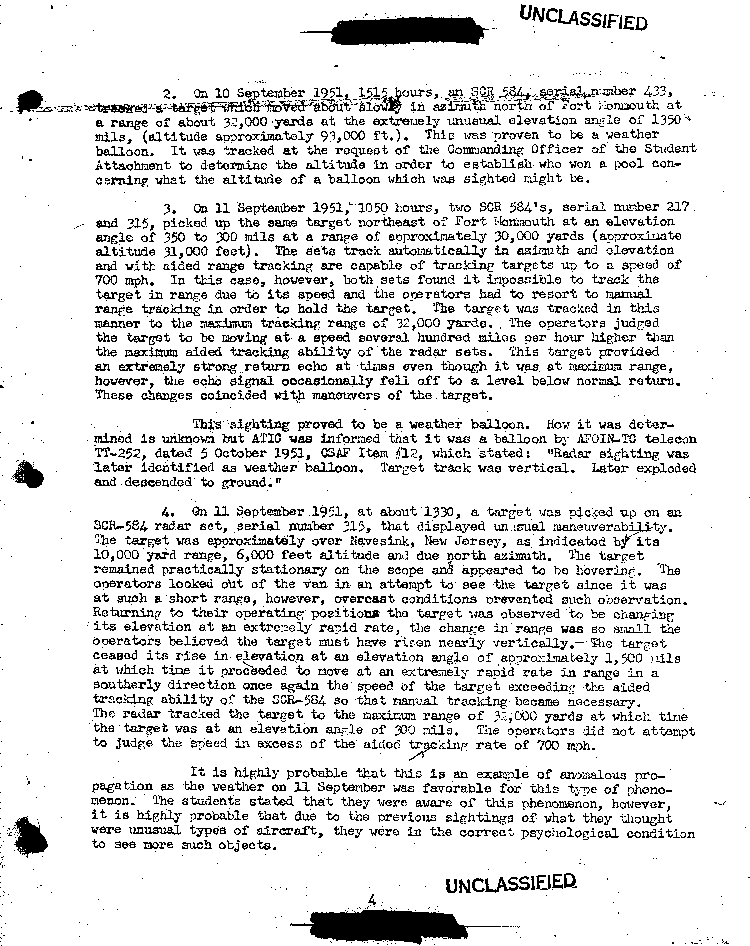1951.
1 2 3 4 5 6 7 8 9 10 11 12 13 14 15 16 17 18 19 20 21 22 23 24 25 26 27 28 29 30 31

|
2. On 10 September 1951, 1515 hours an SCR 584, serial number 433, tracked a target which moved about slowly in azimuth north of Fort Monmouth at a range of about 32,000 yards at the extremely unusual elevation angle of 1350 mils, (altitude approximately 93,000 ft.). This was proven to be a weather balloon. It was tracked at the request of the Commanding Officer of the Student Attachment to determine the altitude in order to establish who won a pool concerning what the altitude of a balloon which was sighted might be.
3. On 11 September 1951, 1050 hours, two SCR 584's, serial number 217 and 315, picked up the same target northeast of Fort Monmouth at an elevation angle of 350 to 300 mils at a range of approximately 30,000 yards (approximate altitude 31,000 feet). The sets track automatically in azimuth and elevation and with aided range tracking are capable of tracking targets up to a speed of 700 mph. In this case, however, both sets found it impossible to track the target in range due to its speed and the operators had to resort to manual tracking in order to hold the target. The target was tracked in this manner to the maximum tracking range of 32,000 yards. The operators judged the target to be moving at a speed several hundred miles per hour higher than the maximum aided tracking of the radar sets. This target provided an extremely strong return echo at times even though it was at maximum range, however, the echo signal occasionally fell off to a level below normal return. These changes coincided with manoeuvers of the target.
This sighting proved to be a weather balloon. How it was determined is unknown but ATIC was informed that it was a balloon by AFOIN-TC telecon TT-252, dated 5 October 1951, CSAF Item #12, which stated: "radar sighting was later identified as weather balloon. Target was vertical. Later exploded and descended to ground."
4. On 11 September 1951, at about 1330, a target was picked up on an SCR 584 radar set, serial number 315, that displayed unusual manoeuverability. The target was approximately over Navesink, New Jersey, as indicated by its 10,000 yards range, 6,000 feet altitude and due north azimuth. The target remained practically stationary on the scope and appeared to be hovering. The operators looked out of the van in an attempt to see the target since it was at such short range, however, overcast conditions prevented such observation. Returning to their operating positions the target was observed to be changing its elevation at an extremely rapid rate, the change in range was so small the operators believed the target must have risen vertically. The target ceased its rise in elevation at an elevation angle of approximately 1,500 mils at which time it proceeded to move at an extremely rapid rate in range in a southerly direction once again the speed of the target exceeding the aided tracking ability of the SCR-584 so that manual tracking became necessary. The radar tracked the target to the maximum range of 32,000 yards at which time the target was at an elevation angle of 300 mils. The operators did not attempt to judge the speed in excess of the aided tracking rate of 700 mph.
It is highly probable that this is an example of anomalous propagation as the weather on 11 September was favorable for this type of phenomenon. The students stated that they were aware of this phenomenon, however, it is highly probable that due to the previous sightings of what they thought were unusual types of aircraft, they were in the correct psychological conditions to see more such objects.
1 2 3 4 5 6 7 8 9 10 11 12 13 14 15 16 17 18 19 20 21 22 23 24 25 26 27 28 29 30 31